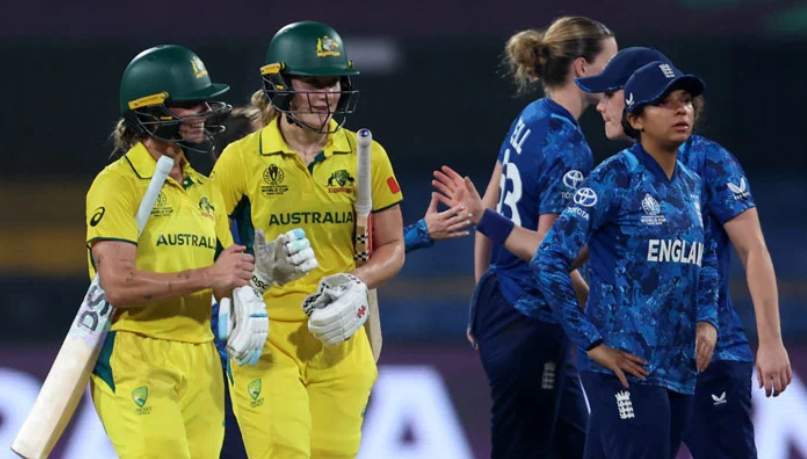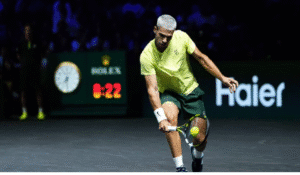Gardner and Sutherland Power Australia to a Statement Win Over England in Women’s World Cup 2025

Meta Description:
Ashleigh Gardner’s stunning century and Annabel Sutherland’s all-round brilliance led Australia to a six-wicket victory over England in the Women’s World Cup 2025, lifting the defending champions to the top of the standings.
Introduction
In what can only be described as a masterclass in composure and counterattack, Ashleigh Gardner and Annabel Sutherland guided Australia to a clinical six-wicket win over England in the ICC Women’s Cricket World Cup 2025.
The victory, achieved with 57 balls to spare, not only reaffirmed Australia’s reputation as the gold standard in women’s cricket but also sent a strong message to the rest of the field: the champions are peaking at the right time.
At Holkar Cricket Stadium, England posted a respectable 244/9 — a total that seemed competitive given the conditions — before Gardner and Sutherland combined for a record-breaking unbeaten 180-run partnership that turned a precarious situation into a dominant win.
England’s Batting: A Solid Start That Fell Short of Impact
England’s innings was a story of promise without punch. The side, led by Tammy Beaumont’s composed 78, built a platform for a 270-plus total but lost momentum in the final overs against disciplined Australian bowling.
Beaumont’s Anchor Role
Beaumont, who has been the bedrock of England’s batting order for years, showcased her classic blend of technique and timing. Her 78 off 105 balls, including ten fours and a six, was a demonstration of controlled aggression. She rotated strike well, punished loose deliveries, and held the innings together when wickets fell at the other end.
However, her dismissal in the 38th over — caught behind off Sophie Molineux — halted England’s flow at a critical stage.
The Supporting Cast: Starts Without Substance
While Beaumont anchored the innings, Nat Sciver-Brunt (32) and Heather Knight (27) provided stability but failed to convert starts into big scores. England’s middle order, once considered among the most consistent in world cricket, looked uncertain against Australia’s spinners.
Danielle Wyatt, brought in for her explosiveness, managed just 18, and although Amy Jones tried to accelerate with a quick 38 off 32, her dismissal triggered a collapse. England lost five wickets for 41 runs in the final 10 overs — a phase that defined the match.
Australian Bowling: Persistence and Precision
Credit must go to the Australian bowlers for maintaining relentless pressure.
- Annabel Sutherland (3/60) was the pick of the attack, using variations of pace and seam movement to break key partnerships.
- Sophie Molineux (2/41) and Ashleigh Gardner (2/48) exploited the sluggish surface, drawing batters into mistimed drives.
- Alana King (1/35) provided control through the middle overs, choking runs when England attempted to accelerate.
By the 50th over, England’s 244/9 looked slightly under par — particularly against a batting lineup as deep as Australia’s.
Australia’s Early Struggles: A Familiar Stutter
Chasing 245, Australia’s innings began with uncharacteristic nerves. England’s seamers, Lauren Bell and Linsey Smith, exploited early movement to leave the defending champions reeling at 68/4 in under 16 overs.
The Top-Order Collapse
Openers Alyssa Healy (14) and Beth Mooney (21) perished trying to force the pace, both caught in the deep off mistimed strokes. Ellyse Perry, the veteran all-rounder, lasted only 11 balls before edging behind for 6, while Tahlia McGrath (17) fell lbw to Smith’s arm ball.
At that stage, England looked poised to pull off an upset. The body language in the field was animated; the bowlers smelled blood. Australia’s dressing room, however, remained calm — and with good reason. Two of their most resilient players were about to rewrite the script.
The Gardner-Sutherland Partnership: Controlled Chaos
Counterattack with Calculation
At 68/4, Ashleigh Gardner joined Annabel Sutherland at the crease. What followed was one of the most calculated and commanding partnerships in Women’s World Cup history.
Instead of going into survival mode, the duo chose counterattack — but not recklessly. They absorbed pressure, picked gaps smartly, and rotated strike with remarkable ease. Once set, they launched into England’s bowlers with surgical precision.
The pair added 180 runs off 148 balls, an unbeaten stand that will be remembered for its blend of composure, timing, and sheer dominance.
Gardner’s Century: Brutality Meets Elegance
Gardner’s innings was a masterclass in controlled aggression. She reached her century off just 73 balls, hitting 16 fours in a display of crisp stroke play. Her ability to manipulate field placements — stepping out against spinners and cutting through point with finesse — left England’s bowlers frustrated.
This was Gardner at her devastating best — the batter who can turn games single-handedly.
“When Gardner starts timing the ball, there’s little a bowler can do,” remarked former captain Meg Lanning in commentary. “She reads length earlier than most and backs herself completely.”
Sutherland’s Supporting Role: A Captain’s Dream
If Gardner was the hammer, Sutherland was the anvil — solid, composed, and quietly brilliant. Her 98 not out off 112 balls showcased maturity well beyond her years. She rotated the strike expertly, allowing Gardner to dominate, yet ensured she capitalized on every scoring opportunity.
The pair’s chemistry was evident — a partnership built on trust, communication, and clarity of role.
“We’ve batted together in domestic cricket and know how to balance aggression and patience,” Sutherland said post-match. “The key was staying calm when we were four down. Once we stabilized, we knew we could control the chase.”
England’s Bowling: Early Joy, Then Desperation
Smith and Ecclestone Shine Early
England’s bowlers began with discipline. Linsey Smith (2/43) extracted movement off the surface and bowled stump-to-stump, claiming the wickets of Mooney and McGrath. Sophie Ecclestone (1/44) was steady as always, beating the bat repeatedly without luck.
However, once Gardner and Sutherland settled in, the English attack lost intensity. Short-pitched deliveries and misdirected yorkers allowed Australia to regain momentum.
The Turning Point
England’s tactical error was perhaps not bringing Nat Sciver-Brunt into the attack earlier. Known for her deceptive medium pace and wicket-taking knack in middle overs, Sciver was introduced too late — by then, Gardner had already seized control.
By the 35th over, Australia needed just 60 runs to win, and England’s bowlers appeared resigned to their fate.
Tactical Breakdown: How Australia Engineered the Comeback
- Batting Order Flexibility:
The decision to send Gardner ahead of Grace Harris at No. 6 provided the innings with experience and intent at the right moment. - Targeting Spinners:
Gardner and Sutherland used their feet effectively, nullifying Ecclestone and Charlie Dean’s spin threat. Both batters attacked the straighter deliveries, forcing England to alter their field placements. - Rotating Strike Relentlessly:
The partnership’s hallmark was constant rotation — avoiding dot-ball pressure and turning ones into twos. - Game Awareness:
Both players showed superb awareness of required run rate and bowler patterns. Their communication between overs — clearly visible on camera — demonstrated leadership under pressure.
Statistical Highlights
- Ashleigh Gardner: 104* (73 balls, 16 fours) – Strike rate 142.47
- Annabel Sutherland: 98* (112 balls, 9 fours, 1 six)
- Partnership: 180* off 148 balls – 2nd highest 5th wicket stand in Women’s World Cup history
- Australia: Chased 245 with 57 balls remaining
- England: 244/9 in 50 overs
The Broader Context: What This Win Means
Australia’s Ruthless Consistency
With this victory, Australia climbed to the top of the ICC Women’s World Cup standings with 11 points in six matches. Their ability to win from difficult situations highlights a team culture built on belief and adaptability.
This win also reaffirms Australia’s depth. Even after losing key wickets early, the middle order had the resilience to finish strong — a hallmark of champion sides.
England’s Struggle for Identity
For England, this defeat exposed lingering issues. Their bowling remains overly reliant on Ecclestone’s spin and Beaumont’s batting. The lack of middle-order acceleration and inconsistent death bowling continues to cost them games against top-tier opponents.
“England are competitive but not ruthless,” observed analyst Mel Jones. “They build pressure but struggle to sustain it when opposition counters.”
England now sit third on the table with nine points, still in semifinal contention but needing to tighten their approach in upcoming fixtures.
The Gardner-Sutherland Era: A Glimpse of the Future
This match may well mark the beginning of a new chapter in Australia’s dominance. For years, stars like Meg Lanning, Ellyse Perry, and Alyssa Healy defined Australian women’s cricket. But in Gardner and Sutherland, Australia has unearthed a next-generation core capable of carrying that legacy forward.
Both players embody modern cricket — fearless, athletic, and multi-skilled. Gardner’s off-spin and batting firepower, paired with Sutherland’s pace and composure, give Australia the perfect all-round balance.
Their partnership on Wednesday wasn’t just about runs; it was about symbolism — a passing of the torch from one golden generation to the next.
Voices from the Camp
Ashleigh Gardner on Her Innings
“It’s about belief,” Gardner told reporters after the match. “When you’re chasing, pressure can make you go defensive. Annabel and I decided early that we’d play our shots and back ourselves. The pitch played true, and once we got momentum, we didn’t look back.”
Annabel Sutherland on the Partnership
“We just wanted to build a partnership. The coaches have been emphasizing communication and calmness under pressure — I think today was the perfect example of that,” she said.
Coach Shelley Nitschke on Australia’s Mindset
“We’ve talked a lot about adaptability,” Nitschke said post-match. “This was a chase where we had to rebuild and then dominate. The girls executed perfectly. Gardner and Sutherland showed why they’re world-class.”
Expert Commentary
Former England captain Charlotte Edwards summed it up perfectly:
“Australia’s success comes from clarity. Every player knows her role, and even when they lose wickets, the belief doesn’t waver. Gardner’s innings was a statement — that Australia’s next era is already here.”
Meanwhile, former Australian legend Lisa Sthalekar highlighted the partnership’s technical brilliance:
“They didn’t just hit boundaries — they manipulated the field. England’s spinners were left guessing. This is high-IQ batting.”
Tournament Implications
With this win, Australia have effectively secured their semifinal berth and positioned themselves as title favorites yet again. Their net run rate — already superior — received a further boost with this emphatic chase.
England, meanwhile, face a must-win scenario in their remaining group matches. To qualify comfortably, they’ll need to beat both New Zealand and India, while improving their death bowling and middle-order strike rates.
Conclusion
The Australia vs England clash in Indore wasn’t just another World Cup game — it was a showcase of mental strength, tactical excellence, and elite execution.
From Tammy Beaumont’s graceful fifty to Gardner and Sutherland’s match-winning heroics, the contest had everything that defines modern women’s cricket: skill, resilience, and spectacle.
Australia’s six-wicket win lifted them to the top of the table and reinforced why they remain the sport’s benchmark. For England, it was another lesson in missed opportunities — and a reminder that against this Australian juggernaut, consistency alone isn’t enough; ruthlessness is mandatory.
As the tournament moves toward its final stages, one truth is clear: in the Women’s World Cup 2025, Australia’s golden glow hasn’t dimmed — it’s only getting brighter.






